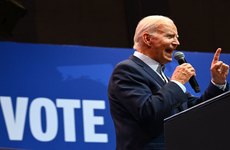The state and local budget crisis is here — and your finances could take a big hit

The Bankrate promise
At Bankrate we strive to help you make smarter financial decisions. While we adhere to strict , this post may contain references to products from our partners. Here's an explanation for .
Recessions are like forest fires. Their flames hop effortlessly from one tree to the next, toppling entire wooded areas if they go unextinguished.
That’s essentially been the synopsis for the coronavirus-induced downturn. What started as distress in tourism and hospitality soon engulfed retailers, restaurants, and now, state and local governments — one corner of the diverse ecosystem that is the U.S. economy at risk of adding more fire to the flame.
Battered by the twin blows of declining tax revenues yet soaring health care and unemployment costs, state and local governments are currently hard-pressed to hit their balanced-budget requirements. The sector employs about an eighth of all U.S. workers and accounts for nearly a tenth of the economy, meaning any cutbacks to get through the trouble could hold back the recovery from the worst economic crisis since the Great Depression, similar to what happened during the last downturn more than a decade ago.
“State and local governments went into this year expecting things to be pretty easy,” says Tracy Gordon, senior fellow at the joint Tax Policy Center between the Urban Institute and the Brookings Institutions, whose research focuses on fiscal challenges facing municipalities. “Instead, they’re faced with this once-in-a-lifetime challenge, on the heels of the Great Recession, which everyone then thought would be a once-in-a-lifetime challenge.”
Here are five ways a state’s budget shortfall could negatively impact your wallet, whether you live there or not.
1. Layoffs, hiring freezes and furloughs for state and local government employees
State and local government budgets aren’t like that of the federal government. In most cases, they can’t run a gaping deficit, though requirements differ from coast to coast.
To make up for shortfalls, cuts are typically a state’s first option. Departments with the largest amount of state funding — what’s normally K-12 education, public safety and health care — are typically the first place officials turn. Other, smaller agencies could be trimmed as well, or states could shift special funds earmarked for another department into the general budget fund.
“If you’re looking at making significant budget cuts, you have to go where the money is,” says Brian Sigritz, director of state fiscal studies for the National Association of State Budget Officers, a nonpartisan research group that advises state budget offices.
When those cuts are enacted, they most often translate into layoffs, furloughs and hiring freezes, Sigritz adds. Education has been hit the hardest by state and local cutbacks so far, accounting for nearly 63 percent of job losses within the industry down nearly 6 percent from a year ago. Eventually, however, more state layoffs outside of education are bound to happen, Sigritz says. “We are expecting to see significant reductions in states’ workforces overall.”
But health care cuts are trickier for a state to justify, according to Gordon. Covering prescription benefits under Medicaid is optional, but states are unlikely to make cuts there because it “ends up costing the whole system more” in the long run, she says. States may also fear that they’re opening themselves up to a lawsuit if they make cuts to community-based services, especially those that can be used as an alternative to institutional care for individuals with disabilities.
A possible policy option could be “trigger cuts,” Gordon says, which are reductions mandated by a governor that only take effect when certain economic conditions are met.
“If the economy turns up, the trigger will turn off,” she says. “It all depends on how creative budget creators can be and how much risk they’re willing to take on.”
2. Constituents could see a tax hike, though most states will try to avoid it
Another way legislatures can fill a budget shortfall is by raising taxes, though that option isn’t as politically viable. States are likely to make budget cuts and then tap into their rainy day funds first, which hit record highs across most states leading up to the recession, though others had less than a week socked away.
“Even though rainy day funds are at record high levels, they alone aren’t going to be enough to solve state budget gaps,” Sigritz says.
Tax increases might be something that governments look into as the downturn and its lingering effects persist, Sigritz says. Along with not appealing to constituents, states may wait because it takes a while for revenues to build up anyway.
That could take even longer if the pandemic continues. With fewer consumers leaving their homes, tax revenues on gas, auto sales and retail spending have declined, though online sales have held up, Sigritz says. Gaming revenues have also fallen as casinos and businesses with sports betting have closed, as have personal income taxes due to layoffs.
Tax hikes would likely be more targeted for most states, with legislatures likely voting to bump up so-called “sin taxes” on items including alcohol and cigarettes. Those revenues have also been resilient for much of the current recession, though it could weigh on consumers’ pocketbooks as the economy slowly recovers.
“The difficulty is, in the middle of a recession when people are already feeling pinched, you don’t want to further burden them with taxes,” Gordon says. Following the Great Recession, “by raising taxes, Uncle Sam was basically, as one newspaper put it, putting money in one pocket and taking money out of the other.”
3. Pensions are at risk of being underfunded, but you should still get them paid out to you
State workers who rely on public pension funds for their retirement income may dread the coronavirus crisis. But former state workers already drawing payments should not feel an impact, nor those on the brink of retirement, though bigger funding issues could arise down the road.
“Longer term, there’s the possibility of not being able to make the full payments,” Sigritz says. “That’s not something that would be (happening) in the next couple of years.”
Most of the problems burdening state pension funds originated before the coronavirus crisis, though it certainly didn’t help, Sigritz says. How the situation looks depends on where you live, with some states such as Illinois and New Jersey facing more significant challenges.
Pension funds typically invest in U.S.-issued bonds and equities, among other asset classes. Adding more pressure to the program, states went into 2020 assuming a higher rate of return than what actually came to fruition. Choppy waters likely lie ahead given to-be-expected election year uncertainty, as well as the path of the recovery. Meanwhile, yields across the curve have tumbled to record lows. Yet, markets for the most part have rebounded after being down by as much as 31 percent in March.
“States might still not see quite as much of a return as they were initially anticipating, but the outlook isn’t quite as bad as it was,” Sigritz says.
Changes to state public pension plans have been more significant since the Great Recession of 2007-2009, with nearly all states reforming their system in some way, according to the National Association of State Retirement Associations. Sigritz says the most common reforms include increasing employee or employer contribution rates and raising the retirement age.
States can defer payments, but that option is “generally frowned upon,” Gordon says. Legislatures generally just kick the can farther down the road, with the method often digging an even deeper hole.
But because of the way the system is set up, it’d be rare for state workers not to get a payment at all, Gordon says. “Even if prefunding is basically zero, you still have that current income from the employer contribution.” What’s most likely is a state doing what’s often called a “tread water contribution,” she says, which is where a state pays interest plus employer service cost — its mandatory payments.
4. States should continue to access capital markets, but don’t chase higher yields in the municipal bond market
Those investing in the $3.9 trillion U.S. municipal debt market might not want to turn a blind eye to states’ budget shortfalls. Though states are unlikely to pull out of credit markets entirely, it all has implications for a state’s creditworthiness.
Similar to the federal government, states can raise cash by issuing municipal bonds (often called “munis”) if they’re facing a crunch that can’t be immediately plugged by hiking taxes or cutting budgets. Typically, these investments are seen as safe, and interest rates have been low.
But the coronavirus crisis flipped the script. Facing unprecedented uncertainty, investors rushed to safety — dumping bonds, leaving the market flush with munis and sending interest rates soaring. The perfect storm made it harder for states to issue debt and pay for borrowing cheaply, prompting Federal Reserve action.
“We have seen a steady decline in the amount of issuance overall. That’s something that could very well continue,” says Cooper Howard, Charles Schwab’s director of fixed income strategy. “But states cutting off issuing debt because of the coronavirus? I don’t see that happening. It’s a very efficient way for them to fund operations.”
It could, however, harm the credit quality of individual issuers, with a state defaulting on its debt a worst-case scenario. Illinois, New Jersey, Connecticut and Hawaii have all notoriously been stretched when it comes to meeting their debt obligations. But the Fed’s involvement in the muni market has helped revive an otherwise slammed market, providing a safety net, Howard says.
Individual investors can find a generous return on the municipal bond market. In many cases, even a highly rated muni can pay more than double the 10-year Treasury yield, according to municipal market data from FMS bonds. But yield chasing isn’t always the best strategy. Howard adds that it’s an important time to move up in credit quality, such as targeting double-A rated or above-average munis.
“Higher in credit quality and returns have outperformed returns from lower-rated issuers,” he says. “What the muni market is seeing right now is distinguishing between the haves and the have-nots.”
5. When state and local governments struggle, so could firms, workers in the private sector
Even though only about 14 percent of workers are employed by state and local governments, the hard-hit sector still has negative consequences for the rest of the economy, given the overall contagiousness of recessions.
“Anytime you see large reductions in state and local spending and increased layoffs, it can harm the economic recovery overall because you’re increasing the number of people who are unemployed and taking money out of the economy,” Sigritz says.
States lost out on an estimated $283 billion during the Great Recession, and revenues held below 2008 levels until 2013 after adjusting for inflation, according to June 2019 research from Pew Charitable Trusts. Nine states still were taking in fewer tax dollars than before the Great Recession of 2007-2009, and half of states were spending less than before that downturn at the time of the report.
It has consequences for the U.S. economy. State and local governments were detracting from growth in almost every quarter from 2009 to 2014, according to the Bureau of Economic Analysis.
Bottom line: Aid for states could be a game-changer
Voices on Capitol Hill are already calling for additional aid to state and local governments, with Democratic lawmakers deeming it one of their highest priorities for Congress’ next fiscal care package.
“During the Great Recession, without aid, states would’ve had to make much more significant spending cuts than they ended up doing. This time around would be a similar scenario,” Sigritz says. “Even with additional federal aid, states are still likely going to have to make cuts, but the magnitude will be much smaller.”
Even so, the longer the coronavirus downturn lasts, and the worse it becomes, the bigger the threat for states — and the broader economy.
“There are a number of things states can do in the short term that will help get them through the crisis. Especially if this is a V-shaped recovery, that might make a lot of sense,” Gordon says. But solutions aren’t as easy “if this is more of an L-shaped recovery, and we’re in this for a while.”
Learn more:
Related Articles

Midterm elections 2022: Here are the key things at stake for your money

The average amount in U.S. savings accounts – how does your cash stack up?

Worried about a potential recession? Here’s 9 steps to prepare your finances now
